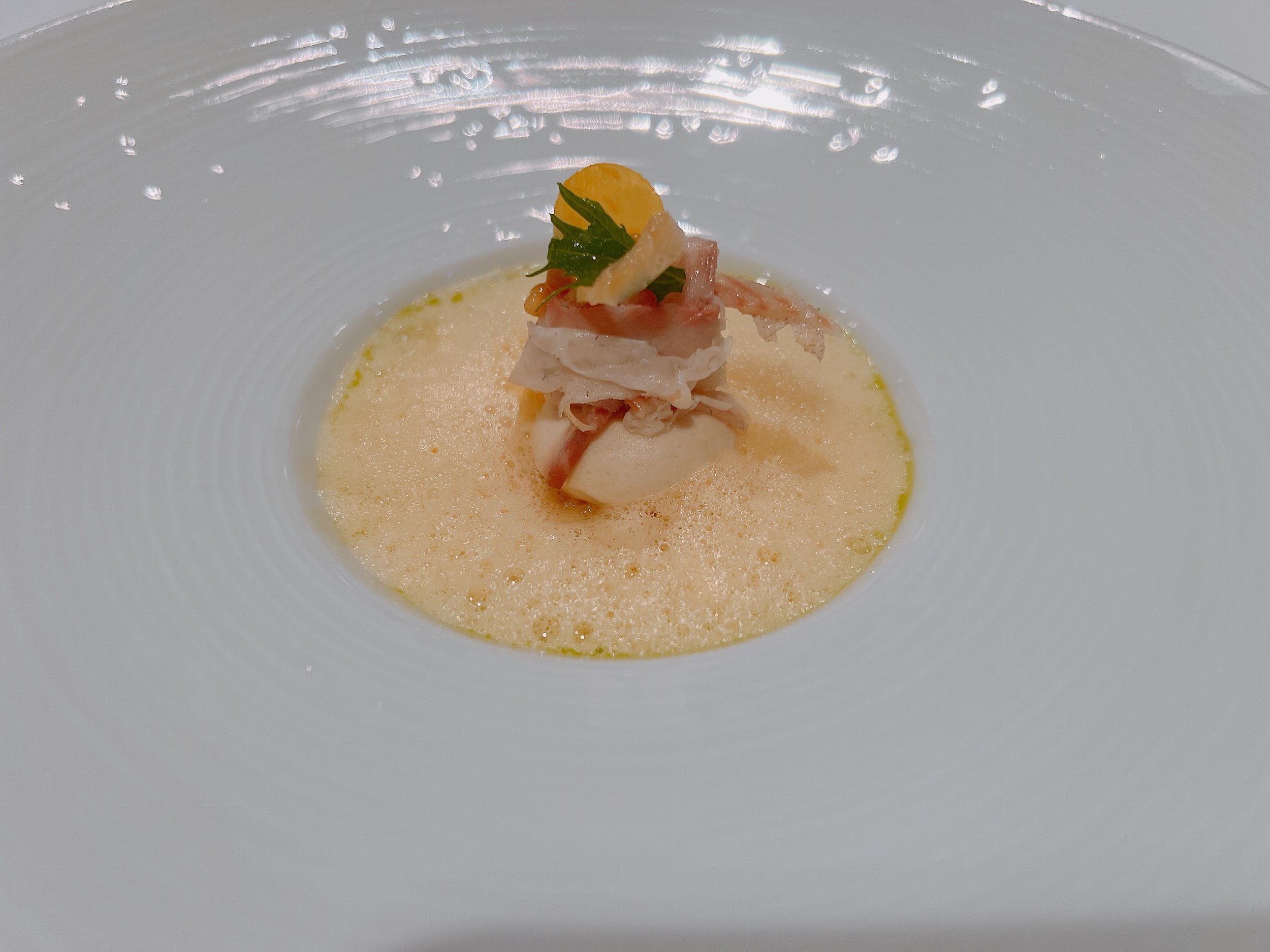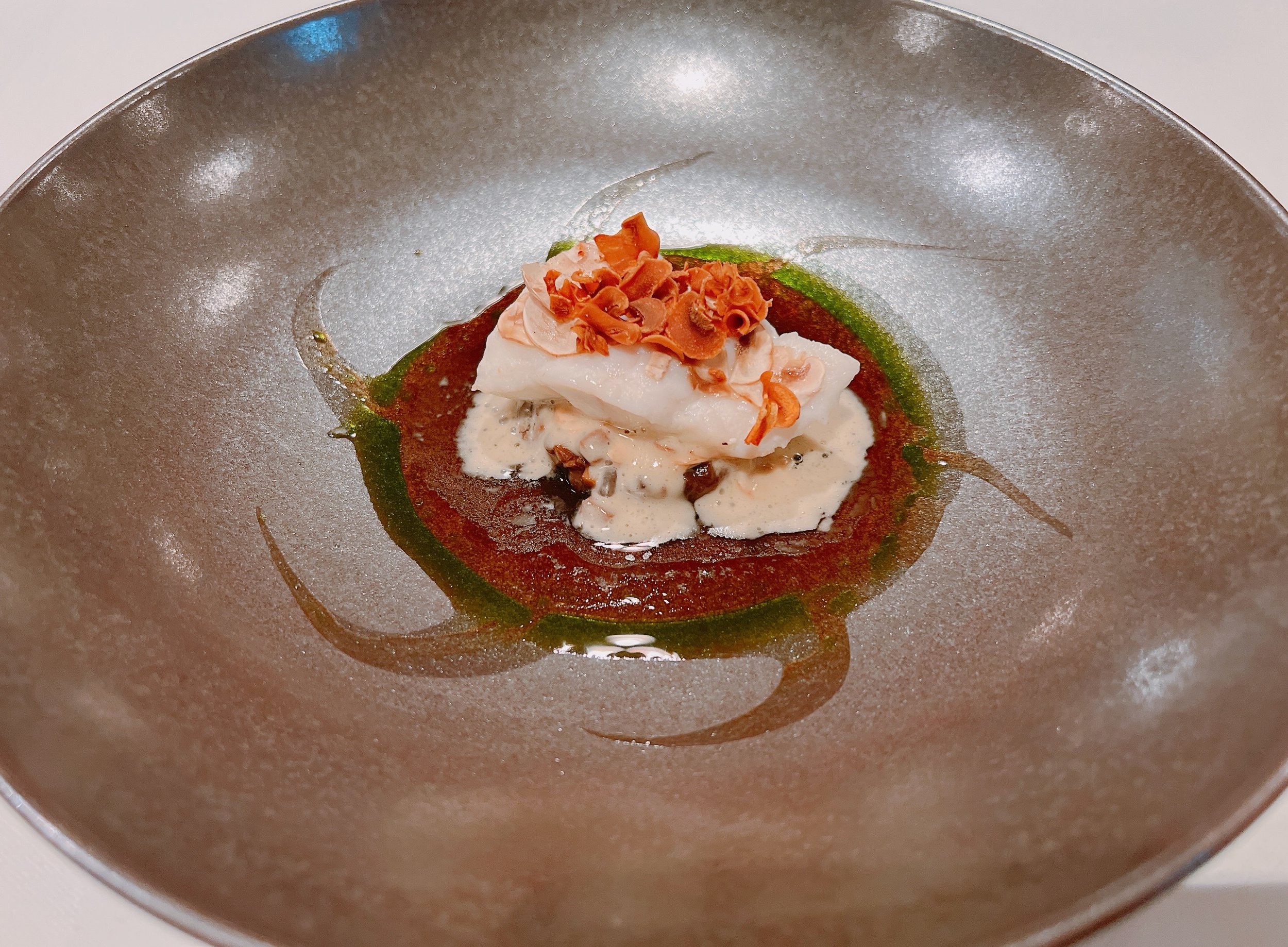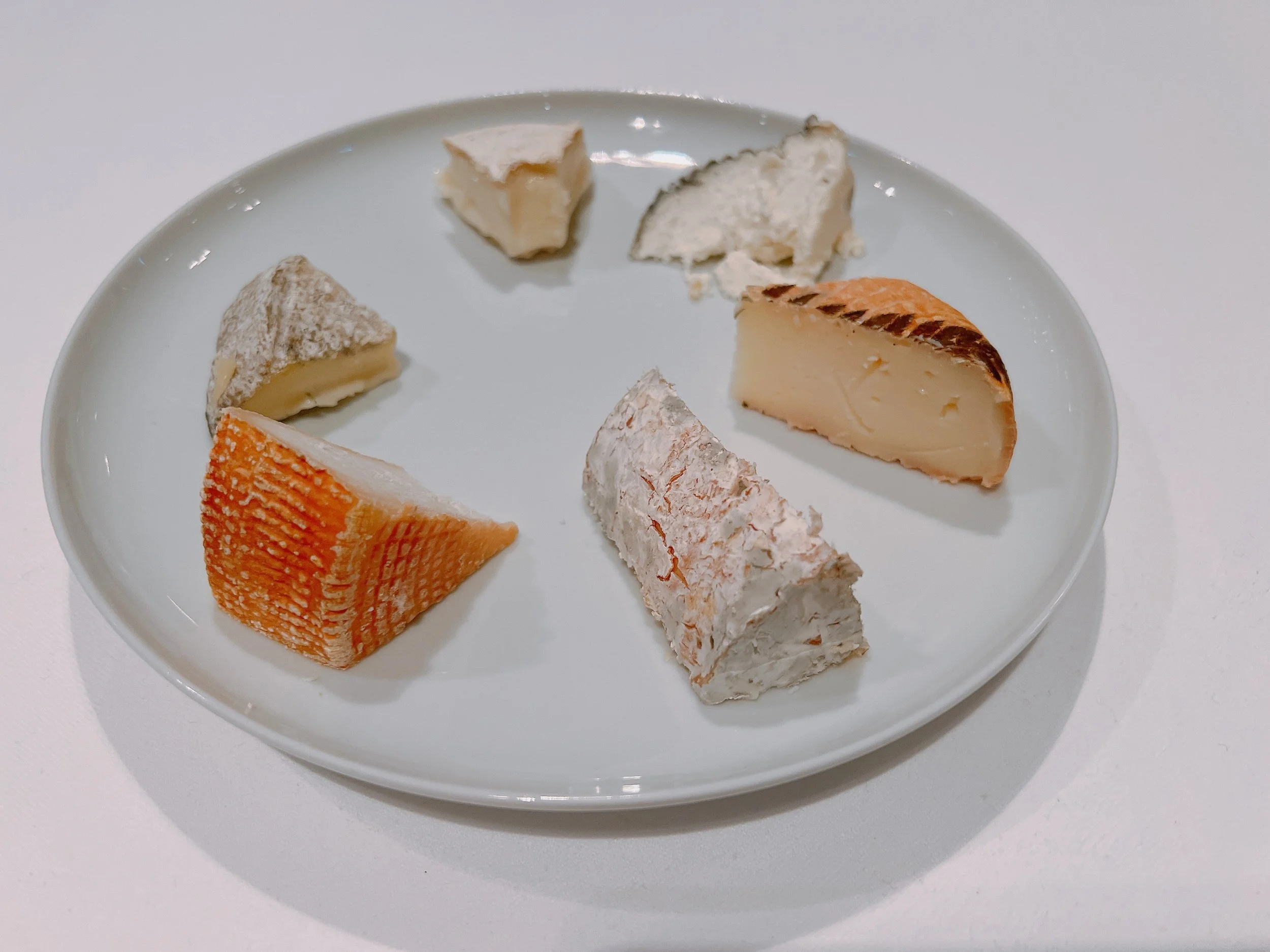Aqua - Wolfsburg
Rating: 18/20
Where: Wolfsburg, Germany
When: Dinner for 9 on 8 December 2023
Cost per Person: Tasting menu 215-245 Euro, Wine pairing 155 Euro
Accolades: 3 Michelin Stars
Why: Modern German cuisine with delicious seafood dishes
“Aqua” is a mainstay among Germany's three-Michelin-starred restaurants. Chef Sven Elverfeld has held the distinction for fifteen years, and several chefs who later earned three stars themselves spent some time in his kitchen - including Jan Hartwig, who most recently received three stars for JAN. My first and only visit to Aqua was in 2009, not long after it earned its third star. High time then for a return visit, with the welcome excuse of a belated birthday dinner with family.
The restaurant's location is a bit unusual. Not since it is in a hotel - the swanky (and only slightly dated) Ritz-Carlton in Wolfsburg -, but because where the hotel itself is: on the premises of VW's Autostadt (car city), the customer-facing part of VW's main production facility. I imagine the main reasons for staying at this hotel are (a) business travel to VW or (b) to pick up your new VW car directly at the factory. For the latter clientele, there are also museums and exhibitions nearby. But presumably there is also a smattering of (c) fine-dining enthusiasts. Getting to the hotel requires driving through an inquisitive security checkpoint, an uncommon prerequisite for having a nice dinner. The restaurant is located at the southern end of the hotel's ground floor overlooking the river passing through the VW plant. During our early December visit, the trees outside were lit up with Christmas decorations.
The ambiance of the dining room was modern, with an understated elegance - think: white tablecloths and the works. Service was professional yet friendly. There were eight tables total on our visit, including two larger parties, but I assume this configuration can be rearranged if, say, only smaller groups are visiting. There were two tasting menus to choose from, “Neues Entdecken” (roughly: new discoveries) and “Meine Verbundenheit” (even more roughly: my culinary roots). The two menus share appetizers and desserts, and on our visit, the former menu was a bit more meat-heavy, while the latter (which we went for) had more seafood dishes. If desired, the tasting menus can be shortened by one or two courses. A wine pairing was also on offer, with all wines being pretty good, and a couple of them excellent. Sadly, some of the wine pours were on the paltry side. True, they were sometimes topped off, but I would have preferred slightly larger servings to begin with. I did appreciate though that modifying the wine pairing to personal taste was no problem, for example, one of my fellow diners went for an all-white pairing. But it's a good idea to order an aperitif to start with since the wine pairing only began after three rounds of amuse bouches.
Speaking of amuse bouches, the first two were served together. A caramelized black olive was filled with a little bit of cream cheese and topped with a sugar chip. One might not think that a strong olive taste would go well with sweetness (a little bit of it, anyway), but it did! A tasty beginning 18. Our next bite was inspired by the Italian classic of “vitello tonnato”. Tuna was wrapped inside a slice of lean veal, which sat on an arugula chip and was topped by some fried capers. Served cold, this dish tasted more of meat than of tuna. Quite good as well 17. The pescatarian version omitted the veal, which left us essentially with a piece of tuna. Compared to tuna sashimi I've had elsewhere, this was fine, but not outstanding 16.
Three kinds of bread were served during our dinner, all arriving warm, and all regularly replaced throughout our meal. They were: a tomato rosemary thyme brioche, a white roll, and a slice of baguette. All were fine, but not amazing. They went well with the (optionally salted) butter and were great for mopping up the sauces in the following courses 16.
The appetizers continued. Smoked eel was served with turnips, arugula, jasmine rice and a saffron sauce. The rice was cooked slightly beyond al dente, and went great with the excellent, slightly salty sauce. The fish was very nice as well, one only wished that the portion size was bigger 17.
The last pair of amuse bouches were a glass of wild boar essence and a warm panko-encrusted praline filled with wild boar meat, black miso, fresh ginger and Asian spices. The broth was a bit odd: it was pretty sweet, and actually tasted more of vegetables than of meat 15. The praline was much better: quite meaty, with the Asian spices being very light 17. The pescatarian alternative replaced the wild boar by mushrooms in both dishes. That actually made the broth better in my opinion. It had a strong mushroom flavor that tasted a bit reconstituted, as if from dried mushrooms 16. The flavor of the praline was lighter than the meat version, relying mostly on the subtle Asian spices 16.
On to the first official course of the tasting menu. Local trout was served with a buttermilk sauce, green paprika, radishes, trout roe and a tempura chip on top. The fish was lovely - perfectly cooked -, and the fresh, crunchy vegetables added some nice texture. A bright, fresh tasting dish, also thanks to the light but flavorful sauce. Very good 18.
Next up: scallops with puntarelle (a kind of chicory), black beans and a mustard foam. Again, this dish was anchored by a great sauce - luckily we had plenty of bread to clean it up with. The slightly sweet scallops were excellent as well; the beans, both mealy and crunchy in texture, added some variety to the dish 18.
Our pescatarians received a shifted menu - the scallops would come later -, and were served a char fish at this point, borrowed from the other tasting menu. Char roe, cucumbers, an avocado cream (hidden under the fish), roasted and chopped beechnuts and an herb salad completed the dish. No surprise at this point: the sauce was again. Equally good was the fish, and the addition of the nutty topping was interesting 17.
The third seafood course was a sole from Brittany, cooked with mushrooms, a bit of veal tongue, a brown butter sauce and a mushroom jus. The sole had a solid bite and an almost meaty texture, but the main taste in this dish was of mushrooms - the veal was barely noticeable. A hearty, autumnal dish appropriate for the season, and my favorite among the seafood courses 19.
Our final savory dish was chicken, topped with a truffle jus, and served with artichokes and a dumpling. The chicken was very tender, flavorful and went great with the truffles. The artichokes were served two ways: as a crunchy “salad” and as a cream, both lovely. The only weak part of this dish was the dumpling - it tasted both a bit dry and overly fried 17.
The cheese course was also pretty good, and included a few excellent cheeses - my favorite was one of the blues. No rating here, since one's experience will vary a lot depending on one's choices. A sure winner though was the warm fig bread that was served on the side: sweet - almost Christmassy - and with a nicely crunchy crust 17.
A palate cleanser of sorts was also one of the restaurant's signature dishes, continuously on the menu since its opening day 23 years ago. Rosé champagne (Ruinart today, a vintage Moet & Chandon in 2009) had been made into a creamy sorbet, which was then served in the upside-down sawed-off bottom of a champagne bottle. Wonderfully creamy, light and soft, this was a truly amazing sorbet. Tastewise, “rosé champagne” wasn't necessarily our first impression, but the dish definitely had a healthy dose of “je ne sais quoi”. Very nice 19.
Our main dessert was called “red currant shrub”, and at its center was a sorbet made not only from red currants, but also from their stems. Surrounding it were a rosemary panna cotta, some hazelnut cakes and a red currant sauce. The sorbet wasn't particularly sweet (especially compared to the champagne sorbet before), and had a touch of spice. While the hazelnut cake was lovely, the panna cotta had an oddly herbal, non-rosemary taste. Some small rolled up cones reminded us a bit of Indian spices. More of an interesting rather than (simply) tasty dessert 16.
Slightly better was the following dessert based on lychees, grapefruit and white chocolate. It was topped by crunchy pearls made from the same three ingredients combined with pop rocks. I liked the playfulness of the pop rocks, but based on the reactions at our table, they weren't for everyone. An interesting dessert that wouldn't look out of place at a children's birthday party 16.
At the conclusion of our dinner, we were allowed to pick some petit fours from a dessert cart. With fifteen choices, not even I was capable of trying them all, so we made due with a smaller sample. A cannelle was quite good, soft on the inside and crunchy on the outside 17. Rose and lychee went together surprisingly well in a praline, although the rose taste dominated 16. White nougat with pistachios tasted more of the sweet pistachios than of the soft nougat 14. A chocolate “bar” filled with crunchy nougat was outstanding, not too sweet and quite crunchy with an elegant aftertaste that combined the caramel and chocolate 19. A praline filled with a caramelized peanut tasted a bit of peanut butter 17. The newest creation of the kitchen was a sage butter praline. It was uncomfortably reminiscent of a savory dish 13. Better was a praline filled with liquid salted caramel 18. A Bailey's praline had a creamy filling that had at most a faint ressemblance to the classic liquor 15. Finally, a passion fruit macaroon unfortunately hardly tasted of the tropical fruit 14.
How does today’s dinner compare to our visit in 2009? Back then, most of the courses were more obviously based on traditional German dishes, nowadays that connection is more subtle. I also remember the 2009 wine pairing to be quite adventurous, serving one wine in a black glass to have us guess its variety (something quite non-obvious IIRC), and including two wines from California (Caymus and Opus One), which rarely happens in Europe.
Overall: Modern German cooking with particularly strong seafood dishes - all uniformly delicious. The amuse bouches and desserts were not quite as successful, but overall we were happy to be back here after a 14 year wait. Definitely worth a stop when in Northern Germany 18.


















